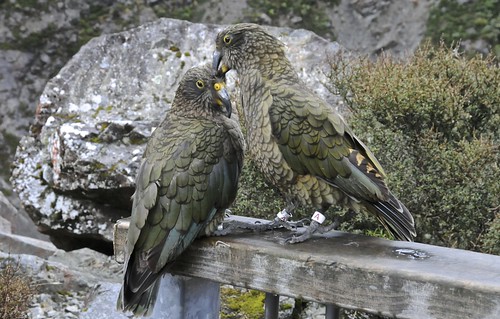 Kea are now considered a threatened species. Image by Brian Ralphs Survey moves two albatross and two shag species to nationally critical status
Kea are now considered a threatened species. Image by Brian Ralphs Survey moves two albatross and two shag species to nationally critical statusSeveral of New Zealand's most cherished birds - among them the kea and two types of albatross - have been shifted to a more serious conservation status following a national survey.
The assessment, lead by Dr Hugh Robertson of the Department of Conservation, audited the status of the 473 species or sub-species of New Zealand birds known to have been alive since the first contact with humans.
Of the total, nearly 12 per cent were now extinct - the moa, huia and Haast's eagle are long gone - while 18 per cent were classed as threatened, and a further 22 per cent were considered at risk.
The audit saw little change in the status of our most high-profile threatened birds.
The Okarito brown kiwi, takahe, kakapo and black robin were among those classified as nationally critical, the king shag and Fiordland crested penguin featured on the nationally endangered list, while those considered nationally vulnerable included the North Island brown kiwi, the great spotted kiwi, the yellow-eyed penguin, the blue duck or whio, the North Island and South Island kaka and the Northern New Zealand dotterel.
But six species had been moved into the nationally critical list, including the Antipodean albatross, the Gibson's albatross, the Chatham Island shag and the Pitt Island shag.
It was the first time the Antipodean albatross had been classified as threatened.
The notoriously cheeky kea, considered the only truly alpine parrot in the world, also made a debut on the threatened list, as did the flesh-footed shearwater, New Zealand storm petrel and lesser knot.
Shorebird ecologist Dr John Dowding, who co-authored the assessment, said little usually changed when a survey was completed, but there were always some differences.
"Some of the ones that go up on the lists, we know are a result of conservation work we've been doing for the past three or four years."
For example, the status of the orange-fronted parakeet and Chatham Island pigeon, or parea, had improved as a direct result of successful management programmes.
"But some of the ones that go down, they're sometimes due to factors that we can't control, especially with seabirds," Dr Dowding said.
These included long-line fishing or changes in oceanic productivity.
The primary aim of the survey, Dr Dowding said, was to prioritise the management of those threatened birds, and prevent their extinction.
Winners and Losers
Winners
• Bounty Island shag
• Orange-fronted parakeet
• Grey-headed mollyhawk
• Chatham Island pigeon/parea
• Eastern Falcon
• Stewart Island robin
• North Island little shearwater
Losers
• Antipodean albatross
• Gibson's albatross
• Salvin's mollyhawk
• Chatham Island shag
• Pitt Island shag
• Black-billed gull
• Flesh-footed shearwater
• New Zealand storm petrel
• Kea
• Lesser knot
The species were designated as either winners or losers in the survey because of positive or negative movement in their conservation status category.